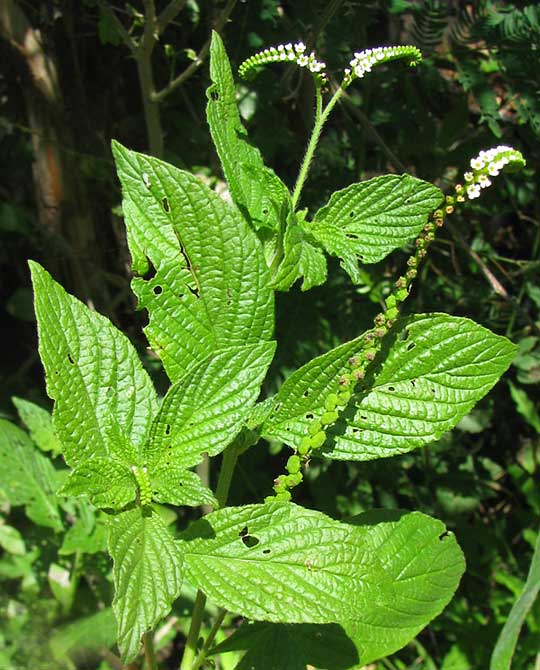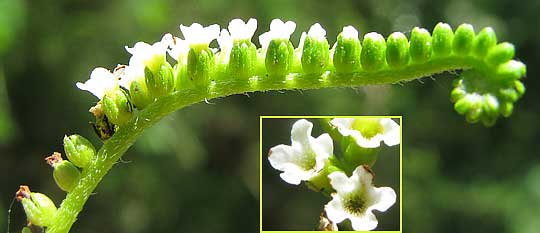Excerpts from Jim Conrad's
Naturalist Newsletter
from the October 10, 2010 Newsletter issued from Hacienda Chichen Resort beside Chichén Itzá Ruins, central Yucatán, MÉXICO; limestone bedrock, elevation ~39m (~128ft), ~N20.676°, ~W88.569°
SCORPION TAIL FLOWERING
Right outside my hut's door there's a much-branched, four-ft-tall (1.2m) weed whose flowers are less interesting than how they're arranged. Take a look below:

Even if you live up North you've probably seen plants similar to this one because this is one of 250 or so species of heliotrope, or turnsole. This one's English name often is given as Scorpion Tail or Butterfly Heliotrope. It's HELIOTROPIUM ANGIOSPERMUM. You can see where the name's scorpion part comes from below:

The curl-tipped inflorescence is suggestive of a scorpion's arched tail.
In the picture, each of those white-topped items along the horizontal rachis is a flower. This inflorescence type, technically referred to as a "scorpioid" raceme, "scorpioid" meaning "scorpionlike" and a raceme being a flower spike whose flowers have no stems, or pedicels. This particular flower head is distinguished not only by its curled scorpioid tip but also by how the flowers arise from just one side of the rachis, generally pointing skyward. The name "heliotrope" translates to "sun seeker."
Heliotropium angiospermum is distributed from southern Florida and Texas through the American lowlands to Brazil; it's a common tropical-American weed. In much of Mexico a tea made from its brewed leaves is generally thought of as helping with stomach problems such as diarrhea, colitis and dysentery.
However, the online Atlas de las Plantas de la Medicina Tradicional Mexicana tells us that none of the species' purported medicinal values have been confirmed scientifically. Moreover, there's a report from Barbados of some boys dying from taking too strong a tea, plus another study says that when fourteen rats were injected with an extract from this plant sarcomas developed in four of the rats at the injection site. At the very least this herb should be used with great care.
If you read Spanish you may enjoy browsing the atlas at http://www.medicinatradicionalmexicana.unam.mx.